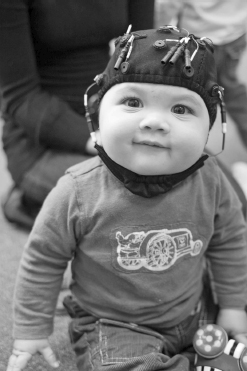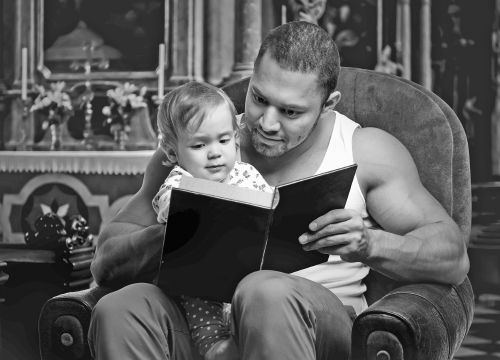Chapter 3
Creating a Thirst for Knowledge
In chapter 2, we saw that parents can prepare their children for reading instruction by ensuring that kids can hear individual speech sounds. It’s noteworthy that this learning takes place over months or even years, and that its impact on reading is invisible to both parents and children. Then, when reading instruction begins, the knowledge suddenly becomes relevant.
The same is true of vocabulary and background knowledge (i.e., general knowledge about the world). You’ll recall from chapter 1 that they are prime contributors to comprehension; they’re needed to fill information gaps that writers leave. Background knowledge takes a central role rather abruptly as reading shifts from being mostly about decoding from kindergarten through second grade to being mostly about comprehension in third grade and beyond. One consequence is that kids who don’t have very rich background knowledge—often those from impoverished homes—start to struggle with reading in third or fourth grade, even though they had been doing fine up to that point. This phenomenon is so often observed that it has a name: the fourth-grade slump.
Obviously, you don’t want to address the need for knowledge in fourth grade, when it becomes urgent. Knowledge accretes slowly, and it’s best to begin at birth. Let’s start with vocabulary.
Building Vocabulary
In what is becoming a repeating theme, I’ll start by observing that things get started earlier than you might guess. Infants learn words well before they can speak. Here’s an example of an experiment showing that. Researchers recorded brain activity in nine-month-olds. A little cap, fitted with electrodes, was put on the infant’s head. Each electrode recorded, through the skull, the activity of the several million neurons below it (figure 3.1).

Figure 3.1. Baby ready to participate in a study that will measure brain activity.
Source: © Cat Thrasher, via CatThrasher.com.
Researchers were looking for a particular brain response that happens when we perceive something meaningful. For example, suppose you were watching a screen and saw each of these letter strings appear, one at a time:
- yare
- pova
- book
The third stimulus would prompt a particular brain response because it’s a meaningful word. Touch the very top of your head, move your finger an inch or two back, and then find spots to the left and right, about an inch or two down. That’s where the response happens, about 0.4 seconds after you see the word “book.”
In this experiment a baby sat on her (or his) mom’s lap, both of them facing a screen. On each trial, Mom would point out an object, even though one was not visible. For example, she might say, “Look, there’s a duck!” Then the screen would drop, and behind it would be either the object she named (a toy duck) or some other object (a brush, for example). Other experiments have shown that the “this means something” brain response is exaggerated when there is a mismatch between meanings. It’s as though you hear the word “duck” and then see a hairbrush, so you’re combing through the part of the brain that deals with meaning, trying to make sense of what just happened. Infants as young as nine months old show this response, strong evidence that they have already learned the meaning of some words.
This result implies that your baby will be learning vocabulary even though he can’t show you that he’s learning it. So talk to him. Describe what you’re doing as you’re making dinner and he’s in his high chair. Ask his opinion about whether to buy yellow or white onions when you’re in the grocery store, even if the question draws only a solemn look. This talk from you doesn’t need to be didactic. It can (and, to my taste, should) be social.
For older children—say, age three and up—there are lots of data showing that children mirror the type of talk that they hear—both talk directed to them and talk that they overhear. I remember being startled when my youngest child, then three, walked up to me and asked, “Daddy, is your lap available?” She had learned the concept of “availability” in reference to materials at her preschool and applied it to my lap, which she required at that moment for sitting.
As always, common sense rules here. I’m not suggesting that you salt your conversation with words you’ve found on a build-your-vocabulary website. “Gosh, José, you’re turning into the house factotum, aren’t you, my boy?” I’m suggesting that you pay attention to how you talk to your kids, with an eye toward perhaps talking more as you do to adults. They can probably handle it and would benefit. And I guess I’m also suggesting not to speak motherese once they are no longer babies. (Part of that, I’ll admit, is personal. It makes my skin crawl to hear a parent in a restaurant use an overly loud, fake-joyous voice to shout in the face of a six-year-old, “Does Biwwy want some owange zuice?”).
Building Knowledge
Between the ages of two and five, your child is a terrific ally in the pursuit of knowledge because that’s when she’s constantly asking you questions. Sure, not all questions from kids are meant to learn things. Sometimes they want your attention (“Mommy?”) and sometimes they make a request (“Can you please open the window?”) or ask for permission (“Can I play Nintendo?”). But about two-thirds of the questions that kids around this age pose are meant to elicit information. They want to learn about their world. You can see their desire in the pattern of questions they ask. About half of them are sequenced; they ask for an explanation of something, for example, and the answer prompts a new question as the child digs deeper. And if the answer doesn’t provide the requested information, the child will ask again.
So the obvious starting point in helping your child to build knowledge is to answer his questions. You are close at hand and know so much. Even better, you’re providing information that he’s shown you he’s curious about. Not only does your child actually get the answer to his question, but it gives you the chance to communicate to him that questions are valued in your family (figure 3.2).

Figure 3.2. Eleanor Roosevelt on curiosity. “I think, at a child’s birth, if a mother could ask a fairy godmother to endow it with the most useful gift, that gift should be curiosity.” In fact every child does have that gift, but it starts to wither in most around age seven. The question for parents is how to ensure a sturdy curiosity throughout childhood. The answer is showing that you value curiosity yourself by honoring it in your child and modeling it in your daily life.
You probably think that you already answer your child’s questions, but even the most responsive parents don’t answer something like 25 percent of the time. It’s easier to understand when you think of the volume of questions that children pose between the ages of two and five. Researchers estimate it’s between four hundred and twelve hundred each week, depending on the child. I know that when my kids were young, my best parenting self understood I should calmly and carefully respond to every question, but there were times I whined, “Can’t I just drink my coffee for five minutes?”
Here are some reasons questions might frustrate you, along with some ideas about how to cope:
If you like the idea of your kids asking you questions and showing curiosity about the world, there is something you can do to cultivate it: ask them questions. Researchers have found that some parents talk to their kids mostly with directions about what to do (“Go to bed”) and what not to do (“Stop that”). Other parents engage in much more communication by question (“It’s Tuesday—where do you think we’re going after school?”). Naturally every parent does some of each, but individuals seem to lean toward one type or the other and in so doing set up a model for their child regarding the nature of communication. If you give a lot of commands, you’re showing your child that the purpose of language is for communicating one’s wishes to others. If you ask a lot of questions, you’re showing your child that the purpose of language is the acquisition of new knowledge.
Some researchers have also suggested that question-asking parents tend to invite conversation even when they tell their children what to do. They do so by offering reasons along with their requests, and a reason invites a counterargument. For example, a parent might say, “You had better go to bed now, or you’ll be too tired to get up in time for school.” The child can then try to subvert the reason: “But remember, last week I stayed up until 9:30 and I wasn’t tired the next morning.” In contrast, the parent who simply says, “Go to bed,” offers no opening for the child to bargain or reason for a later bedtime.
Reading Aloud
When you think of activities parents might undertake to develop their child’s knowledge, reading aloud is probably high on your list (figure 3.4). Indeed, there’s good evidence that read-alouds help toddlers gain broader vocabulary and understand more complex syntax. Why? Think about the language that children overhear in the conversations of their parents. Even preschoolers’ books have richer vocabulary than that used by college-educated adults in typical conversation. Furthermore, conversations are full of interruptions and unfinished sentences, and when the sentences are complete, the syntax is usually quite simple.

Figure 3.4. Reading aloud. When the National Academy of Education commissioned a report on reading in 1985 written by ten prominent reading researchers, they named reading aloud as the most important activity to get more kids reading.
Source: © Alex Tihonov—Fotolia. For the report, see Anderson (1985).
Since we’re talking about building background knowledge, it seems natural that we’d think about including nonfiction in read-alouds. It’s a great idea. It lets your child know that books are not only narratives and there are terrific nonfiction selections available. As always, I’d be sensitive to what your child likes. If my fabulous book about pond life made my child cry for Curious George, I’d read her Curious George. But I’d try a different nonfiction book a couple of days later.
Read-alouds don’t help children learn how to read when they get to kindergarten, but again, we wouldn’t expect them to. In kindergarten children are learning to decode. The benefit of reading aloud is a benefit to the child’s knowledge and vocabulary, and so it appears only around grade 3 or 4.
How Do You Get Started?
There’s no reason not to read to a newborn, and by “newborn” I mean just home from the hospital. (That’s what the American Academy of Pediatrics recommends.) At the same time, while reading may be a nice reason to hold your baby, you should probably be aware that he can’t really see much of the book. At birth, babies’ vision is 20/500 (meaning they can see at twenty feet what an adult with good vision sees at five hundred feet.) They also don’t have typical color vision until three months (they can’t see blues), and it’s at that age that they start to be able to focus better. Furthermore, babies are much more social at three months than at three days. So for my money, three months is a good time to begin reading to them.
The main (or, really, only) thing I was doing with my infant children when I read to them was establishing a bedtime ritual—something we both enjoyed and that helped them wind down and understand that it was time to sleep. So it was a simple matter of propping the child in my lap, holding the book so she could see it, and reminding myself that it was okay if she didn’t really pay attention or started chewing the book. If you set more ambitious goals for reading to an infant, you might think that the child is getting exposed to some vocabulary or that you’re laying the groundwork for the alphabetic principle (the idea that letters represent sounds) and that the book is guiding what Daddy says (figure 3.5).

Figure 3.5. Learning vocabulary from picture books. If you want your very young child to learn vocabulary from read-alouds (which was never one of my goals), your best bet is a book with one object per page. Read the label while pointing to the object. Just say “cat.” Not, “Look, there’s a cat. You have a cat too, don’t you? Look this one is gray but yours is brown, isn’t it?” If you’re interested in your child learning something, make plain what is to be learned.
Source: © Wichittra Srisunon—Fotolia.
Dialogic Reading
If you’re really concerned about maximizing the chances that your child will learn from read-alouds, you can consider using another technique, dialogic reading. You’ll recall that print referencing (discussed in the previous chapter) was meant to teach kids about letters. Dialogic reading makes it more likely that kids will learn new vocabulary and more complex sentence syntax from read-alouds. The steps of dialogic reading form an acronym, PEER:
Say you’re reading a picture book and there is a barnyard scene. You might point to a tractor and ask, “What’s that?” (the Prompt). The child replies, “It’s a truck.” You say, “Yes, it’s a type of truck” (the Evaluation). “That type of truck is called a tractor” (the Expansion). “Can you say tractor?” (the Repetition).
There are lots of different prompts you might use; not all prompts ask the child to identify something. You might ask the child to relate something in the book to his own experience. You might ask him to describe what’s happening in the picture. You can ask at the end of a book what happened to one of the characters.
Some parents find dialogic reading a bit formal. I understand; it does feel a bit teachy and as if it might take some of the fun out of read-alouds. Still, you should know that it’s been thoroughly studied, and dialogic reading reliably has a big impact. Not only does it show more benefit to kids’ language ability than simply reading aloud; the latter often doesn’t show much positive impact at all. I believe the research, but it should be borne in mind that these studies are of relatively short duration. I suspect that reading aloud, even if it’s casually done, is still of value over the long term. So if dialogic reading really rubs you the wrong way, don’t feel that’s the only way you can read to your two-year-old. Or do dialogic reading on occasion to feel it out; or your child may like it more than you think.
Commonsense Read-Aloud Tips
Even if you’re not going to use a prescribed method of reading aloud, I think some principles are worth your consideration. Here are some non-research-based ideas on reading to a toddler or preschooler:
Electronic Books for Read-Alouds
Is a read-aloud any different with an electronic book? Studies have compared children listening to an audio version of a book with reading a paper version or e-book with a parent. The outcome measures might be story comprehension, or improvements in hearing speech sounds, or better knowledge of letters. Some studies show e-readers superior to paper, some show them inferior, and some show no difference. Some studies indicate that parents and children interact differently when reading an electronic book together, although the impact is not consistently good or bad for the child.
Why are the data all over the place? Very likely because e-books for kids can take so many forms. For example, suppose that when the child touches a picture of an animal, its name is spelled on the screen. That might boost letter awareness if the letter-sound pairs are simple (“dog”) but not if they aren’t (e.g., “jaguar”). This interactive feature might contribute to story comprehension if drawing attention to the animal helped the child make sense of the narrative. If not, it might be a distraction that detracts from comprehension.
•••••••••••••
There’s just one problem with all the advice I’ve been offering about reading aloud. I’ve been assuming that the idea pleases your child. What if he’s not interested? It’s time to turn our attention to the question of motivation.
Notes
“Infants as young as 9 months show this response”: Junge, Cutler, and Hagoort (2012); Parise and Csibra (2012).
“children mirror the type of talk that they hear”: Weizman and Snow (2001); Zimmerman et al. (2009).
“I’m suggesting that you pay attention to how you talk to your kids”: Landry et al. (2012).
“two-thirds of the questions that kids around this age pose are meant to elicit information”: Chouinard, Harris, and Maratsos (2007).
“it’s between four hundred and twelve hundred each week, depending on the child”: Chouinard et al. (2007).
“you’re showing your child that the purpose of language is the acquisition of new knowledge”: Tizard and Hughes (1984).
“question-asking parents tend to invite conversation even when they tell their children what to do”: Lareau (2003).
“read-alouds help toddlers gain broader vocabulary and understand more complex syntax”: Hood, Conlon, and Andrews (2008).
“it appears only around grade 3 or 4”: Dickinson, Golinkoff, and Hirsh-Pasek (2010).
“consider using another technique, dialogic reading”: Arnold and Whitehurst (1994); Zevenbergen and Whitehurst (2003).
“more likely that kids will learn new vocabulary and more complex sentence syntax from read-alouds”: Justice and Pullen (2003); Mol, Bus, de Jong, and Smeets (2008).
“e-readers superior to paper”: For research concluding that e-readers are superior to paper, see Korat, Segal-Drori, and Klien (2009); Segal-Drori, Korat, Shamir, and Klein (2009).
“some show them inferior”: For research showing them to be inferior, see de Jong and Bus (2002); Matthew (1997); and Trushell, Burrell, and Maitland (2001).
“some show no difference”: For research showing no difference, see de Jong and Bus (2004); Korat and Or (2010); and Korat and Shamir (2007).
“parents and children interact differently when reading an electronic book”: Parish-Morris, Mahajan, Hirsh-Pasek, and Golinkoff (2011); Segal-Drori et al. (2009).
